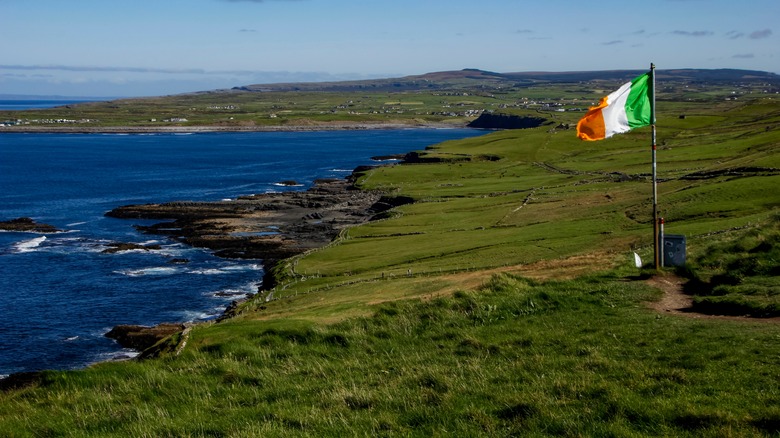What Irish Food Looked Like Before The First Potato
When most people think of Irish food, they think of potatoes. This singular crop has come to dominate the country's cuisine or at least the international perception of it. This is due in no small part to the legacy of the Potato Famine, known in the Irish language as "An Gorta Mor," which means "The Great Hunger" (via History). Between 1845 and 1852, a blight of mold destroyed a majority of Ireland's potato crop, resulting in roughly one million deaths by starvation. At least a million more fled the country, and the famine's influence on the Irish diaspora defines its international legacy. Many Irish immigrants came to the United States, and their stories were heavily characterized by the potato.
The fascinating truth of the matter is that potatoes were still relatively new to Ireland when the famine began. According to Bon Appétit, potatoes, which are native to Peru, were not introduced to Ireland until the late 1600s. To put that into perspective, St. Patrick lived in the 400s, meaning he never ate a potato in his life. So, if you're fixing a plate of colcannon for St. Patrick's Day, you're over a thousand years out of touch with the man himself. But then, what food would be more appropriate? Irish cuisine has become so entwined with potatoes that few people even consider what it looked like before spuds came to Europe. A look back in time reveals a culinary legacy defined by resourcefulness and marred by political strife.
Before potatoes, dairy dominated the Irish diet
The "Emerald Isle" is fittingly covered by lush green pastures, and cows were once the pride and joy of Ireland. However, Bon Appétit reveals that beef seldom appeared on ancient Irish plates; it was dairy that dominated their diets. A 1690 account from a British visitor claims that the Irish people had more than 20 different ways of consuming milk, including bainne clabair ("thick milk"), which was akin to sour cream. Irish butter, which is still highly regarded, was an even bigger deal in ancient times. Records dating back to the 12th century describe compound butters made with garlic and onions. Smithsonian Magazine also mentions butter packed into barrels and buried in peat bogs, which acted as a natural refrigerator. People are still finding ancient barrels of "bog butter" to this day.
Of course, dairy wasn't the only thing Irish people used to eat. Irish Central cites an 8th-century poem titled "Marbán to Guaire" or "The Hermit's Song." It describes Ireland as a bountiful land where the author feasts on salmon and trout, as well as a diverse array of nuts, berries, and herbs. Bon Appétit notes that grains were another staple, particularly oats. Porridge and griddled oatcakes were popular, but wheat struggled to grow in the Irish climate and was mostly reserved for the wealthy. One thing you probably don't associate with Irish food is seaweed, but along the island's coast, it was a popular base for salads.
Traditional Irish cuisine died out under British rule
If you're wondering why you've never heard of bainne clabair or Irish seaweed salad, you can blame the potato. More accurately, you can blame the force that made Ireland so dependent on potatoes, and that was the British Crown. Per History, England assumed total control of Ireland in 1801, its Protestant monarchy subjugating the native Catholics. Laws were passed forbidding Catholics from owning any land, and much of the island fell into the hands of English landlords. The Irish were forced to work as tenant farmers, exporting most of their bounty to England. The Washington Post reveals that even during the height of the Potato Famine, Ireland was sending massive amounts of grain, vegetables, livestock, seafood, and that oh-so-precious butter to England.
Bon Appétit argues that "enforced poverty" under British rule destroyed the historical food culture of Ireland, forcing the locals to give up traditional dishes and rely on potatoes. BBC Travel explains that tenant farmers had to pay rent for their land, so they naturally wanted to maximize their yield per area. Potatoes have tremendous nutritional value and a single acre of land could yield enough potatoes to feed a large family. By the time of the famine, potatoes accounted for 80% of Ireland's calorie intake. That reliance is what made the Great Hunger so devastating, and it erased millennia of culinary history.


